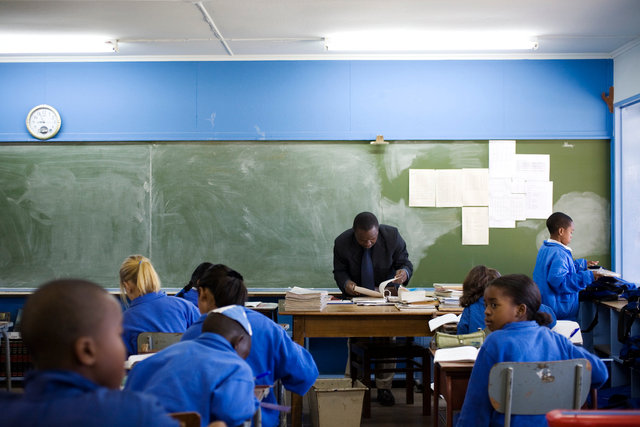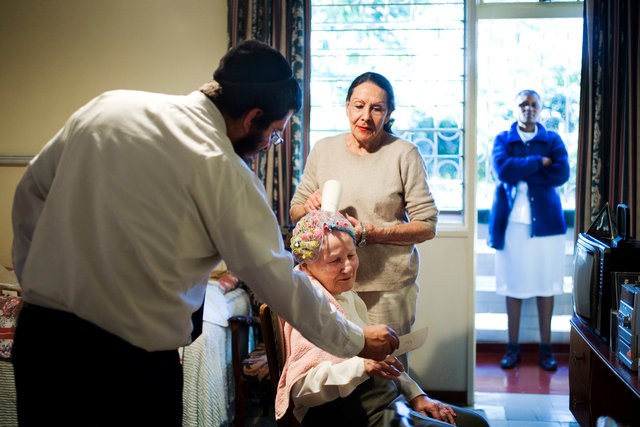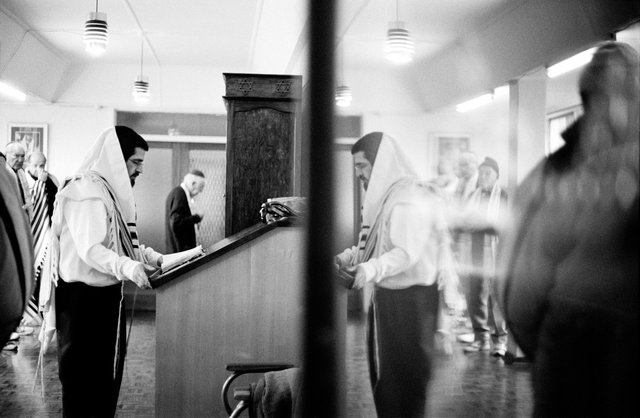
Rabbi and the Lions
Rabbi Asmoucha was walking with lion cubs at Antelope Park. They have a program breeding African lion cubs as part of a rehabilitation project. What was remarkable was the way the lion cubs interacted with the Rabbi, keeping him at the front while playfully swatting his feet.

Carmel Carpool
The small Mazda 323 car held seven children plus two adults driving carpool to the Jewish school, the Carmel School.

Carmel School
Prayers during assembly at the Carmel School.

Carmel Hebrew Lesson
Every Friday morning before the rest of classes begin Rabbi Asmoucha led an optional Hebrew class. To reflect the student body Hebrew class was optional, and Jewish studies program became religious studies, presenting the different religions with an emphasis on Judaism.

Carmel Classroom
The community has maintained a Jewish elementary day school called Carmel School since 1958. It is a unique institution as at the time of this photograph there were only five remaining Jewish students out of two hundred, making the school a very multicultural environment. Of the five Jewish students two were the Rabbi’s children. The remaining students were mostly Christian, followed by Hindu and Muslim faiths; they are of Ndebele, Shona, Asian, and European descent.

Carmel Grade 0
The grade 0 students on break in the school yard of the Carmel School in Bulawayo Zimbabwe.

Carmel Hatikvah
Every Friday morning assembly after the Shabbat service the students sing the Hatikvah followed by the Zimbabwean national anthem.

Dov Asmoucha
Dov doing his homework at the kitchen table. He was learning Hebrew and Hungarian as he was born in Israel, and his mother is from Hungary.

Beilah’s Wedding Photograph
Baileh Bloch is showing her wedding photograph. She was married to Dr. Eric Bloch who works as a consultant for the governor of the Reserve Bank of Zimbabwe.

Eric Bloch and Yoel
Eric and Baileh Bloch had invited the Asmoucha family for Sunday lunch, one of the few kosher homes in Bulawayo. This image was taken of Eric pouring Yoel a Coca-Cola at the bar in their home. Coca-Cola has a very strong presence in Zimbabwe, and is one of the few treats the Rabbi’s children can enjoy. Eric met Baileh his wife at the Jewish African Conference, and their children were very active in Habonim. Now their grown children and grandchildren all live outside Zimbabwe.

Havdalah Lesson
At the end of Shabbat Rabbi Nathan Asmoucha leads a lesson connected to the service being read that day. This ritual involves the men enjoying the occasional scotch, Coca-Cola, challah, and a little something to eat.

Kiddush Levenah
After the Havdalah service at Sinai Synagogue the congregants met outside for Kiddush Levanah, which is a blessing inspired by the waxing cycle of the moon. In this image Max Sher is helping Peeps Golden onto the grass.

Yoel and the Hitchhiker
After visiting the Matopos National park we took a hitchhiker who worked there home. It is increasingly difficult to take public transportation with the gas shortages and fare hikes.

Rabbi's children
We were driving towards Gweru for a family a holiday at Antelope Park. Zimbabwe does not have any back seat seatbelt laws, so the children sit in the back hatch of the Mazda 323. Not many cars are seen on the highways, as gas is very expensive, and hard to find. On a couple hour drive you might pass fifty cars on a highway.

Mrs. Barnett
Tess Barnett eighty-nine years old in this photo. She dated her husband during World War II, and he had the portrait painted, on the left side of the photograph, while he was in Italy to remember her by. When moving to Savyon Lodge Tess took part of her garden along with her gardener to the unmanicured grounds. She also brought furniture from her home to make her one bedroom apartment a real home.

Visiting Zelda Baron
Rabbi Asmoucha is visiting Zelda Baron at Savyon Lodge, while she is getting her hair done by Joy Treger, who also resides at Savyon Lodge. Joy was encouraged to move to by her family to Savyon Lodge after it became unsafe to live alone on the farm. Zelda came to Zimbabwe from Lithuania after being sent by her husband who had been her Yiddish teacher. We were listening to Klezmer music while her hair was being done.

Sinai Shul
This photograph was taken of the event hall at the Sinai Complex.

Caretaker Mr. Sibanda
This image is from a series about the Jewish community in Bulawayo Zimbabwe. Duncan Sibanda worked as the caretaker for the Bulawayo Hebrew Congregation for sixty-four years. Retired, Mr. Sibanda had become almost blind, and was living with his wife close to the burnt down synagogue at the time of this portrait. After he passed away the Rabbi asked for a photo of Mr. Sibanda, he named him Sukali, and apparently he had another English name Dustan. The Jewish community knew him as Duncan. It is quite typical in Zimbabwe to have a few names.

SGOFOTI and Ruth Feigenbaum
Ruth Feilgenbaum photographed here was the founder of SGOFOTI in Bulawayo. Support Group of Families of Terminally Ill. SGOFOTI helped the orphans and their families in the townships struggling in the HIV-AIDS epidemic. This organization also helped women looking after AIDS orphans, by giving them a place to congregate to make items for sale. SGOFOTI is still continuing under Patricia Chadalala's leadership. Ruth was also a strong member of the Jewish community in Bulawayo. Her household was one of the only kosher homes in the city, and she was always incredibly hospitable. Ruth Feigenbaum recently passed away. I am grateful to have met Ruth, seeing her in action and around her diner table. Ruth's support of my brother and his family during their four years in Zimbabwe was unwavering.

Savyon Lodge Dining Room
Mr. Leizer Abrahamsom was the oldest member of the community at one hundred and seven when this was taken. Originally from a shtetle near Bialistok, Poland he came to Bulawayo in 1926 to join his brother. This age is an accomplishment, especially in a country where the average life expectancy for a man is thirty-seven years old. He recently passed away.

Savyon Lodge Prayers
Rabbi Nathan Asmoucha, my brother, used to lead early morning prayers many times a week at Savyon Lodge, the only Jewish home for the aged in Zimbabwe. Savyon Lodge, had approximately thirty residents at the time of this photo, in 2006, they were a third of the whole Jewish community remaining in Bulawayo.

Bulawayo Hebrew Congregation After the Fire
The Bulawayo Hebrew Congregation began in 1894 as a canvass tent with twenty-one members. In 1945 plans were put in place to enlarge the synagogue to fit the congregation. This building partially burned to the ground on October 5th, 2003, the day before Yom Kippur. In the month before this Rabbi Asmoucha had arrived to his first rabbinical posting in Bulawayo, and soon became crucial to the spiritually centering of the Jewish community. After the fire the synagogue became an open air church, where the mikvah remains open to the few younger Jewish women of the community.

The Bulawayo Hebrew Congregation
The Bulawayo Hebrew Congregation began in 1894 as a canvass tent with twenty-one members. In 1945 plans were put in place to enlarge the synagogue to fit the congregation. This building burned to the ground on October 5th, 2003, the day before Yom Kippur. The previous month Rabbi Asmoucha had arrived to his first rabbinical posting in Bulawayo, and soon became crucial to the spiritually centering of the Jewish community. The photograph was taken in the lobby to the synagogue where the memorial plaques were displayed.

Mikvah Footprints
The mikvah survived the fire of the Bulawayo Hebrew Congregation on October 4th, 2003. The sale of the burnt building, now an open air church, was done on condition that the mikvah would be kept open for the remaining Jewish women.

Bulawayo Hebrew Congregation Windows

Rafi Dining
Rafi is the youngest of the three Rabbi’s boys. Lunch is the largest meal of the day. Food preparation requires more planning as there are shortages of milk, eggs, and bread, and there is very little ready made kosher food. Many shortages are due to economics, and a breakdown of the farming community. While in Bulawayo there were bread shortages due to the inflation rate of over 1,200 percent. Making the supplies more expensive than the regulated price for bread.
